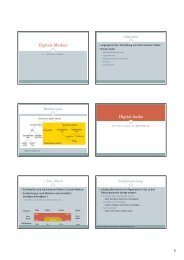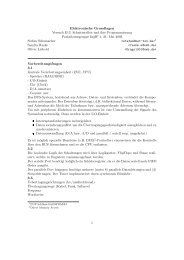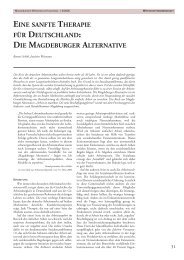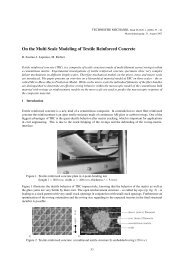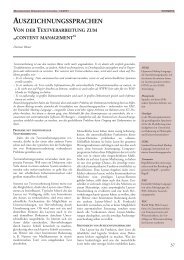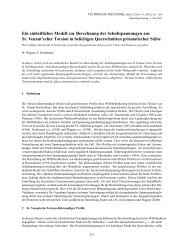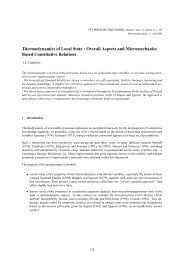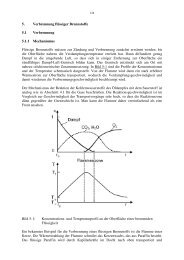Bonds
Bonds
Bonds
You also want an ePaper? Increase the reach of your titles
YUMPU automatically turns print PDFs into web optimized ePapers that Google loves.
Chapter 11:<br />
Liabilities, on and off balance sheet<br />
General issues<br />
Long-term debt, contingent liabilities<br />
Leasing<br />
1
Liabilities, definition and classification<br />
• present obligations based on past transactions or events that<br />
require either future payment or future performance of services<br />
A liability is a present obligation of the enterprise arising from past<br />
events, the settlement of which is expected to result in an outflow from<br />
the enterprise of resources embodying economic benefits. [IASC<br />
Framework, paragraph 49]<br />
<br />
<br />
recognized when incurred; end-of-period adjustments may be<br />
necessary<br />
valued at the amount due or at fair market value<br />
<br />
classified as current or long-term; determinable or contingent<br />
2
Long-term / current<br />
• Long-term Liability<br />
<br />
<br />
due beyond the current period or the normal operating<br />
cycle, whichever is longer<br />
used to cover long-term financing needs<br />
• Current Liability<br />
<br />
<br />
<br />
due within one year or within the normal operating cycle,<br />
whichever is longer<br />
incurred in connection with operating process<br />
long-term liabilities may contain a current portion according<br />
to the lapse of time<br />
• to be shown separately<br />
3
Part I: Current Liabilities<br />
• Accounts Payable<br />
<br />
<br />
<br />
sometimes called trade accounts payable<br />
balances owed to others for goods and services purchased<br />
on open account<br />
time lag between resource inflow and payment<br />
• Short-Term Bank Loans<br />
<br />
<br />
<br />
„line of credit“ – short-term borrowing when needed<br />
promissory note over the full amount uses to be signed<br />
interest rate may vary over time<br />
? Current liabilities as a percent of total liabilities for the Bank of New York and<br />
AT&T are approximately 80 percent and 40 percent, respectively. Explain why these<br />
two companies carry such different levels of current liabilities.<br />
4
Notes Payable, accounting treatment when<br />
granted<br />
<br />
<br />
written promises to pay a certain sum on a specified future<br />
date<br />
used to secure loans or to pay suppliers for goods<br />
Case 1 - Interest stated separately<br />
Sep 30 Cash 10.000<br />
Notes Payable 10.000<br />
(To record issuance of 9%,<br />
90-day note to Commerzbank)<br />
money received equal<br />
to face value of note<br />
Case 2 - Interest in face amount<br />
money received equal to<br />
present value of note<br />
Sep 30 Cash 9.779<br />
Discount on Notes Payable _221<br />
Notes Payable 10.000<br />
(To record issuance of zero-interest-bearing<br />
90-day note to Commerzbank)<br />
5
Accounting treatment of payment<br />
Case 1 - Interest stated separately<br />
Dec 30 Notes Payable 10.000<br />
Interest Expense _225<br />
Cash 10.225<br />
(To record payment of<br />
Commerzbank interest-bearing<br />
note and accrued interest at<br />
maturity)<br />
interest expense<br />
= 10.000 x 9% x 90/360<br />
Case 2 - Interest in face amount<br />
interest expense is lower in<br />
case 2 than in case 1 since the<br />
effective amount borrowed<br />
was lower, too.<br />
Dec 30 Notes Payable 10.000<br />
Cash 10.000<br />
(To record payment of note<br />
with interest included in<br />
face amount)<br />
Dec 30 Interest Expense ____221<br />
Discount on Note Payable 221<br />
(To record interest<br />
expense on note payable)<br />
6
other current debt<br />
• Current Maturities of Long-Term Debt<br />
<br />
<br />
<br />
portions of long-term debt maturing within the next year are<br />
classified as current liabilities<br />
e.g. installment due on a long-term liability, i.e. a loan<br />
no journal entry necessary<br />
• Short-Term Obligations Expected to Be Refinanced<br />
<br />
<br />
don‘t require use of working capital within the next year<br />
enterprise needs to demonstrate intent and ability to<br />
refinance the obligation<br />
• Dividends Payable<br />
<br />
<br />
liability is incurred after the board‘s decision to pay out<br />
dividends<br />
liability exists until dividends are paid<br />
7
Unearned Revenues<br />
• examples:<br />
<br />
<br />
<br />
<br />
sale of season tickets for a sports club<br />
subscription of magazines<br />
gift certificates<br />
meal tickets<br />
• accounting treatment<br />
<br />
<br />
when payment is received: debit cash, and credit unearned<br />
revenue account<br />
when revenue is earned: debit unearned revenue, and credit<br />
an earned revenue account<br />
Type of Account Title<br />
Business Unearned Revenue Earned Revenue<br />
Airline Unearned Passenger Ticket Revenue Passenger Revenue<br />
Restaurant Unearned Meal Revenue Meal Revenue<br />
Magazine Publisher Unearned Subscription Revenue Subscription Revenue<br />
Sports Club Unearned Ticket Revenue Ticket Revenue<br />
8
Economic function of unearned revenue<br />
• recognize unearned revenue when customers are<br />
entitled to receive future service for their present<br />
payment with certainty<br />
<br />
to be distinguished from warranty reserves<br />
Example – Microsoft<br />
‣ unearned revenue increased year after year<br />
‣ u.r. arise from sale of Windows and Office<br />
you do not buy just the current version but future<br />
improvements as well<br />
‣ if sales are growing so is unearned revenue<br />
Increases in unearned revenues may signal favorable future<br />
development!<br />
9
Sales and Excise Taxes Payable<br />
• federal and state authorities levy taxes on retail<br />
transactions or rendering of services<br />
tax collected by seller and then remitted to tax authority<br />
to record a (gross) sale of € 232 given a sales tax of 16%,<br />
the following entries are required:<br />
Cash Sale<br />
Apr 19 Cash 232<br />
Sales 200<br />
Sales Taxes Payable 32<br />
<br />
similar entries to record collection of excise tax excise<br />
tax payable<br />
10
Taxes<br />
• Income Taxes Payable<br />
<br />
<br />
<br />
expense in the year the income is earned<br />
estimated because tax files are subject to review and<br />
approval<br />
debit income taxes expense, credit income taxes payable<br />
• Property Taxes Payable<br />
<br />
<br />
<br />
fiscal year of tax authority often differs from the firm‘s fiscal<br />
year<br />
depending on period chosen to charge the taxes, estimates<br />
may be necessary<br />
provision for property taxes usually by a monthly accrual in<br />
the company‘s books during the fiscal period of the taxing<br />
authority for which the taxes are paid<br />
11
Contingencies<br />
• Definition<br />
„ ... an existing condition, situation, or set of<br />
circumstances involving uncertainty as to possible<br />
gain (gain contingency) or loss (loss contingency) to<br />
an enterprise that will ultimately be resolved when<br />
one or more future events occur or fail to occur.“<br />
[FASB] Statement of Financial Accounting Standards No.5, par.1 (1975)<br />
<br />
<br />
<br />
Gain contingencies are not recorded.<br />
Loss contingencies are not existing liabilities, but potential<br />
liabilities<br />
liabilities contingent on occurence or nonoccurence of a<br />
future event<br />
12
Example<br />
• Dream Cars Inc., a car dealer, offers various<br />
specialties to its customers:<br />
<br />
<br />
Free repair of newly bought cars in case of defect within the<br />
next two years<br />
Free inspection on request by new customers within the<br />
next six months with purchase of 4 new tires before<br />
christmas (as a christmas customer appreciation special)<br />
• No definite liability incurred; Uncertain:<br />
<br />
<br />
<br />
payee<br />
due<br />
amount.<br />
• Nevertheless<br />
<br />
<br />
it is probable, that a liability has been incurred, and<br />
the liability can reasonably be estimated.<br />
Record the estimated amount as a contingent liability!<br />
13
Accounting for contingencies under US-GAAP<br />
Event<br />
Contingent Loss<br />
Contingent Gain<br />
Probability of<br />
Occurence High Reasonable Remote High Reasonable Remote<br />
Is it estimable?<br />
Yes No<br />
Accounting<br />
Treatment Accrue Disclose Disclose Ignore Disclose Ignore Ignore<br />
Source: Pratt, p. 432.<br />
14
Common instances of loss<br />
contingencies/contingent liabilities:<br />
• Litigation, claims, and assessments<br />
<br />
the cause for legal action occurred in the past<br />
probability of unfavorable outcome assessed accoding to past<br />
experience<br />
estimate of expected loss: legal action is decided but number of<br />
claimants uncertain<br />
pending litigation vs. actual/possible claims and assessments: no<br />
exact amounts disclosed due to influence on position before the<br />
court<br />
• Guarantee and warranty costs<br />
guarantee for credit default<br />
product warranty<br />
• Premiums and coupons.<br />
• Environmental liabilities.<br />
• Pensions and other postemployment benefit obligations.<br />
see following pages<br />
15
Guarantee and warranty costs<br />
• Warranty: guarantee to repair or replace defective<br />
goods during a predetermined period following the<br />
sale<br />
• accounting either<br />
<br />
<br />
Cash Basis – warranty costs charged to period in which<br />
company complies with the warranty<br />
Accrual Basis – warranty costs charged to period of sale as<br />
operating expense<br />
• Example (accrual basis): Michael Drums sells music<br />
instruments. Per 100 units sold, 2 require warranty service. The<br />
cost per service is estimated at € 70. In 2002, he sold 800 units.<br />
Five warranty services have already been performed at costs<br />
totalling € 430. So there remain eleven warranty services as an<br />
estimated liability.<br />
16
Journal entries for the example:<br />
1. Sale of 800 units at average price € 100<br />
Cash or Accounts Receivable 80.000<br />
Sales 80.000<br />
2. Recognition of warranty expense<br />
Warranty Expense 430<br />
Cash,Inventory, or Accrued Payroll _ _430<br />
(warranty costs incurred)<br />
Warranty Expense 770<br />
Estimated Liability under Warranties _ _770<br />
(to accrue estimated warranty costs)<br />
3. Recognition of warranty costs incurred in 2003 (on 2002 sales)<br />
Estimated Liability under Warranties 770<br />
Cash, Inventory, or Accrued Payroll _ _770<br />
17
Premiums and coupons<br />
• Examples<br />
<br />
<br />
<br />
frequent-flyer programs<br />
bonus cards of department stores<br />
toys that come with McDonalds junior meals<br />
• Accounting problem again: estimation of the liability<br />
incurred with the sales<br />
<br />
(to comply with the matching principle)<br />
• Journal entries – similar to „Drums example“<br />
18
Example: Frequent-flyer program<br />
• America West Airlines (Phoenix, Arizona), „Flight<br />
fund“ started in 1987, over 1 million active members<br />
<br />
<br />
program is the company‘s single largest current liability<br />
(„Air traffic liability“)<br />
Air traffic liability, $ 240 million (34% of current liabilities)<br />
• Estimation<br />
<br />
<br />
<br />
<br />
How many people are eligible for free air travel?<br />
How many will redeem mileage during the current period?<br />
Where are their destinations?<br />
cost estimate for possible „free“ travel: „incremental cost<br />
method“<br />
19
The World‘s Frequent Flyers...<br />
Frequent-flyer miles<br />
Number of miles Cumulative Number of miles Cumulative Cumulative un-<br />
Year awarded by the awarded miles redeemed by redeemed miles redeemed miles/<br />
airlines* to date* members to date program liability<br />
to date*<br />
1981 4,1 4,1 1,9 1,9 2,2<br />
1982 16,8 20,9 12,9 14,8 6,1<br />
1983 38,5 59,2 28,6 43,4 15,8<br />
:::<br />
2000 1.440,0 10.009,3 349,5 3.379,1 6.630,2<br />
2001 1.600,0 11.609,3 341,6 3.720,7 7.888,6<br />
2002 1.646,0 13.255,3 402,9 4.123,6 9.131,7<br />
*Totals (in billions) adjusted to reflect expiration of approximately 9-11% of airline miles.<br />
Note: Due to trends in award activity, we estimate that 16-34% of all awards will go unredeemed.<br />
This includes expirations.<br />
Source: http://www.webflyer.com/company/press_room/facts_and_stats/liability_accumulation.php<br />
20
Environmental liabilities<br />
• result from obligation to clean up, say, toxic waste or to<br />
landscape sites no longer used for business<br />
sometimes very hard to estimate the liability<br />
indemnity claims after environmental catastrophes<br />
• For example: Bayer AG<br />
“[28 ] Other provisions<br />
Other provisions are valued in accordance with IAS 37<br />
(Provisions, Contingent Liabilities and Contingent Assets)<br />
using the best estimate of the extent of the obligation. Interestbearing<br />
provisions are discounted to present value. Personnel<br />
commitments mainly include annual bonus payments, long<br />
service awards and other personnel costs. The miscellaneous<br />
provisions include € 131 million for restructuring. Provisions<br />
for environmental protection relate to future relandscaping,<br />
landfill modernization and the remediation of land<br />
contaminated by past industrial operations. Sufficient<br />
provisions have been established for such commitments.”<br />
[Bayer AG, Annual Report 2000, notes to financial statements.]<br />
21
Part II: Long-term liabilities<br />
• <strong>Bonds</strong><br />
<br />
<br />
<br />
<br />
<br />
Definition of a bond<br />
Why issuing bonds<br />
Types of bonds<br />
Accounting for bond issues<br />
Accounting for bond retirements<br />
• Long-Term Notes Payable<br />
• Reporting and Analysis of Long-Term Debt<br />
22
<strong>Bonds</strong><br />
• securities issued by, e.g. corporations or<br />
governmental agencies, to obtain large-sum longterm<br />
financing<br />
• normally due ten to fifty years after issue<br />
• various covenants and restrictions for protection of<br />
both lenders and borrowers<br />
• small denominations allows collection of large sums<br />
of money<br />
• interest payment<br />
<br />
<br />
annually or semiannually<br />
zero bonds<br />
• „bond issue“ refers to total number of bonds issued<br />
at one time<br />
23
Why issue bonds?<br />
• to obtain large sums of money for long time that<br />
cannot be collected otherwise e.g. from banks<br />
• debt financing has some advantages over equity<br />
financing<br />
<br />
<br />
<br />
stockholder controls remains unaffected<br />
tax savings: interest expense is tax deductible<br />
leverage effect: spread between return on assets and<br />
interest cost is usually positive and increases return on<br />
equity<br />
• Stock financing vs. bond financing – an example<br />
€ 2 million needed to fund a project<br />
alternative I – issues 100.000 shares at current price of € 20<br />
per share<br />
alternative II – issuance of € 2 million, 9% bonds at face<br />
value<br />
24
Funds obtained by ... issuance of ... issuance of<br />
additional shares<br />
bonds<br />
(250.000 shares (150.000 shares<br />
outstanding)<br />
outstanding)<br />
Earnings before interest<br />
and income taxes € 700.000 € 180.000 € 700.000 € 180.000<br />
Interest 0 0 180.000 180.000<br />
Earnings before income taxes € 700.000 € 180.000 € 520.000 € 0<br />
Income taxes at 35% 245.000 63.000 182.000 0<br />
Net income € 455.000 € 117.000 € 338.000 0<br />
Earnings per share € 1,82 € 0,47 € 2,25 0<br />
RoE 9.1% 2.34% 11.27% 0%<br />
Note: Net income under bond financing is lower than under stock financing, but return<br />
on equity may be higher.<br />
Note that interest cost will increase with leverage because of an increasing default<br />
risk.<br />
Volatility of earning increases.<br />
25
How to issue bonds ?<br />
• usually, approval by board of directors and general meeting of<br />
shareholders necessary; authorized:<br />
number of bonds<br />
total face value and nominal interest rate<br />
• face value: amount of principal the issuer must repay at maturity<br />
• nominal interest rate determines amount of cash interest the issuer<br />
has to pay (also stated rate of interest)<br />
bonds are taken by investment banks („underwriters“) and sold to<br />
the public<br />
underwriters buy bonds for resale or on a commission basis<br />
bondholders are represented by a trustee, typically a large bank<br />
contract between company and bank is called bond indenture<br />
specifies terms of the bond, rights, privileges, and limitations of<br />
bondholders<br />
• bondholders receive bond certificates as evidence of the<br />
company‘s debt to the bondholder; bondholders are creditors !<br />
26
Types of <strong>Bonds</strong><br />
• Secured and Unsecured <strong>Bonds</strong><br />
<br />
<br />
secured bonds: bondholders have a claim to certain assets<br />
of the company upon default, e.g. mortgage bond<br />
unsecured bonds: issued against general credit of borrower<br />
(debenture bonds)<br />
• Term and Serial <strong>Bonds</strong><br />
<br />
<br />
term bonds: all bonds of an issue mature on the same date<br />
serial bonds: bonds mature over several maturity dates<br />
• Registered and Coupon <strong>Bonds</strong><br />
<br />
<br />
registered bonds: corporation maintains record of all<br />
bondholders<br />
coupon bonds: bond not recorded in the name of the owner;<br />
transferable by delivery<br />
cont‘d next page<br />
27
Types of <strong>Bonds</strong>, cont‘d<br />
• Convertible and Callable <strong>Bonds</strong><br />
<br />
<br />
convertible bonds: bonds that can be converted into<br />
common stock at the option of the holder<br />
• bonds furnished with a stock option to reduce coupon<br />
callable bonds: bonds that can be retired before maturity at<br />
the issuer‘s option<br />
• Income and Revenue <strong>Bonds</strong><br />
<br />
<br />
income bonds: interest payment only if company is<br />
profitable<br />
revenue bonds: interest on the bonds is paid from specific<br />
revenue sources<br />
28
Bond Ratings<br />
• Moody‘s Investors Service, Standard & Poor‘s Corp.<br />
and Fitch are the dominating rating agencies<br />
Original Rating<br />
(Historical)<br />
Default Rate*<br />
AAA 0.52%<br />
AA 1.31%<br />
A 2.32%<br />
BBB 6.64%<br />
BB 19.52%<br />
B 35.76%<br />
CCC 53.38%<br />
*Percentage of defaults by issuers rated by Standard & Poor‘s over the past 15 years, based on<br />
rating they were initially assigned. /// Data: Standard & Poor‘s<br />
29
Accounting for <strong>Bonds</strong> Payable<br />
• bonds are traded in the capital market<br />
<br />
market rate (effective yield) of interest and (current) bond<br />
prices are inversely related<br />
• yield rate: the virtual interest rate r a bond purchased at the<br />
current price in the market yields to the owner<br />
• Let c denote the coupon, B the bond price, T the maturity<br />
(time to repayment), face value = F.<br />
• Then r is the solution to the following equation:<br />
⎛<br />
⎜<br />
⎝<br />
c<br />
⎞<br />
F<br />
T<br />
t ⎟ +<br />
t= 1 1<br />
T<br />
=<br />
∑<br />
( 1 + r) ( + r)<br />
⎠<br />
• The yield for longer term debt uses to be higher than for<br />
shorter term debt (normal term structure of interest rates)<br />
• yield rate (bond price) depend on credit rating<br />
B<br />
30
Accounting for <strong>Bonds</strong> Payable<br />
face value € 300.000<br />
stated rate of interest 7%<br />
market rate of interest 10% 12%<br />
schedule of payments year 1 year 2 year 3 year 4 year 1 year 2 year 3 year 4<br />
interest € 21.000 € 21.000 € 21.000 € 21.000 € 21.000 € 21.000 € 21.000 € 21.000<br />
principal € 300.000 € 300.000<br />
present value of interest € 66.567 € 63.784<br />
present value of principal € 204.904 € 190.655<br />
present value (selling price) of the bond € 271.471 € 254.440<br />
31
Inverse relation between interest rates and bond prices<br />
B<br />
200<br />
180<br />
160<br />
140<br />
120<br />
100<br />
80<br />
60<br />
40<br />
20<br />
0<br />
2 4 6 8 10 12 14 16 18 20 % r<br />
bond #1 – stated<br />
rate of interest of c 1<br />
= 5% and term to<br />
maturity of T 1<br />
= 10<br />
bond #2 -stated<br />
rate of interest of<br />
c 2<br />
> c 1<br />
and term to<br />
maturity of T 2<br />
=T 1<br />
bond #3 -stated<br />
rate of interest of<br />
c 3<br />
=c 1<br />
and time to<br />
maturity T 3<br />
= 5 < T 1<br />
assumption: bonds 1-3 have the same face value = 100<br />
32
Stated rate of interest, market rate of interest,<br />
effective rate of interest, and bond issue prices:<br />
• The stated rate of interest i = c/F maydifferfromthe<br />
market rate of interest<br />
<br />
since the yield must be equal to the market rate the issue<br />
price must be adapted accordingly:<br />
• If the stated rate is<br />
<br />
<br />
lower than the market rate: issue price lower than face<br />
value, bond sells at a discount<br />
higher than the market rate: issue price exceeds face value,<br />
bond sells at a premium<br />
• at the date of issue<br />
⎛<br />
⎜<br />
⎝<br />
c<br />
⎞<br />
F<br />
T<br />
t ⎟ +<br />
t= 1 1<br />
T<br />
=<br />
∑<br />
( 1 + r) ( + r)<br />
⎠<br />
B<br />
must hold with a given market rate r<br />
33
Issuing <strong>Bonds</strong> At Face Value (“at par”)<br />
• stated rate of interest i = r market rate of interest<br />
• accounting entry: cash proceeds = face value of the bonds<br />
<br />
Example: 5-year term bonds, face value of € 900.000, dated<br />
January 1, 2004, interest rate 8%, annual interest payments on<br />
January 1.<br />
To record issuance of bonds on January 1<br />
Cash 900.000<br />
<strong>Bonds</strong> Payable 900.000<br />
To record accrued interest expense at year end (December 31)<br />
Bond interest expense 72.000<br />
Bond interest payable 72.000<br />
34
Issuing <strong>Bonds</strong> at Discount<br />
• stated rate of interest i < r market rate of interest<br />
Example: as before, but market rate of interest now 10%<br />
(stated rate of interest 8%).<br />
5<br />
∑<br />
t= 1<br />
72.000<br />
t<br />
1,1<br />
+<br />
900.000<br />
1,1<br />
5<br />
=<br />
831.766<br />
discount is 68.234<br />
<br />
has to be amortized over the time to maturity<br />
• usually: straight line method: 68.234 / 5 = 13.647<br />
35
Issuing <strong>Bonds</strong> at Discount<br />
To record issuance of bonds on January 1<br />
Cash 831.766<br />
Discount on <strong>Bonds</strong> Payable 68.234<br />
<strong>Bonds</strong> payable 900.000<br />
To record accrued interest expense and accrued amortization at year-end<br />
(December 31)<br />
Bond interest expense 85.647<br />
Discount on <strong>Bonds</strong> Payable 13.647<br />
Interest Payable 72.000<br />
Balance sheet presentation:<br />
Long-term liabilities<br />
<strong>Bonds</strong> Payable € € 900 900.000 000<br />
Less: Discount on <strong>Bonds</strong> Payable 68.234 112.159 € 831.766 € 787.841<br />
36
Issuing bonds at a premium<br />
• stated rate of interest i > r market rate of interest<br />
Example: as before, but market rate of interest now 6%<br />
To record issuance of bonds on January 1<br />
Cash 975.823<br />
Premium on <strong>Bonds</strong> Payable 75.823<br />
<strong>Bonds</strong> payable 900.000<br />
To record accrued interest expense and accrued amortization at year-end<br />
(December 31)<br />
Bond interest expense 56.835<br />
Premium on <strong>Bonds</strong> Payable 15.165<br />
Interest Payable 72.000<br />
Balance sheet presentation<br />
Long-term liabilities<br />
<strong>Bonds</strong> Payable € 900 € 000 900.000<br />
Add: Premium on <strong>Bonds</strong> Payable 75.823 133.901 € 975.823 € 1.033.901 37
Amortizing Bond Premium / Bond Discount<br />
• the bond premium (discount) is amortized over the<br />
life of the bonds<br />
<br />
<br />
straight-line method<br />
effective interest method<br />
• Straight-line method<br />
<br />
equal amounts of the premium (discount) are amortized in<br />
each period, equal interest expense recorded in each period<br />
<br />
<br />
<br />
<br />
interest expense = interest to be paid + amortized discount<br />
amortized discount = (face value – issue price) / number of<br />
interest periods<br />
interest expense = interest to be paid – amortized premium<br />
amortized premium = (issue price – face value) / number of<br />
interest periods<br />
38
Effective interest method<br />
• interest expense = bond carrying value ×<br />
effective rate of interest<br />
discount amortization = interest expense –<br />
interest to be paid<br />
premium amortization = interest to be paid –<br />
interest expense<br />
increasing amounts are amortized in each period<br />
• interest expense is equal to a constant percentage<br />
of the carrying value of the bonds<br />
• interest expense recorded is, thus, increasing<br />
under discount<br />
and decreasing under premium amortization<br />
39
Effective interest discount amortization schedule for<br />
an 8% bond sold to yield 10%<br />
Annual interest paid interest discount unamortized bond carrying<br />
period expense amortization discount value<br />
issue date 68.234 831.766<br />
1 72.000 83.177 11.177 57.057 842.943<br />
2 72.000 84.294 12.294 44.763 855.237<br />
3 72.000 85.524 13.524 31.239 868.761<br />
4 72.000 86.876 14.876 16.363 883.637<br />
5 72.000 88.364 16.364 0 900.000<br />
40
The journal entry to record accrued interest at December 31, 2004, is<br />
Bond interest expense 83.177<br />
Discount on bonds payable 11.177<br />
Bond interest payable 72.000<br />
... and bond interest expenses will keep rising as the carrying value of the<br />
bonds increases.<br />
41
Effective interest premium amortization schedule for<br />
8% bonds sold to yield 6%<br />
Annual interest paid interest premium unamortized bond carrying<br />
period expense amortization premium value<br />
issue date 75.823 975.823<br />
1 72.000 58.549 13.451 62.372 962.372<br />
2 72.000 57.742 14.258 48.115 948.115<br />
3 72.000 56.887 15.113 33.002 933.002<br />
4 72.000 55.980 16.020 16.982 916.982<br />
5 72.000 55.019 16.981 1 900.001<br />
42
The journal entry to record accrued interest on<br />
December 31, 2004, is<br />
Bond interest expense 58.549<br />
Premium on bonds payable 13.451<br />
Bond interest payable 72.000<br />
... and bond interest expenses will keep falling as the<br />
carrying value of the bonds decreases.<br />
43
Zero <strong>Bonds</strong><br />
• bonds that bear no interest (explicitly) and are issued solely for<br />
cash<br />
• also called deep discount bonds<br />
Example: An 8-year zero bond with face value of € 10 million<br />
(10.000 x € 1.000 each) is issued and sold at a price of € 3.270.000.<br />
• What is the implicit interest rate ?<br />
€3.270.000<br />
= €10.000.000⋅(1<br />
+ i)<br />
−8<br />
i =<br />
10.000.000<br />
8 −1<br />
3.270.000<br />
=<br />
0,14999<br />
• The implicit interest rate is 15%. It is the interest rate that<br />
equates (in present value terms) the cash received with the<br />
amounts to be paid in the future.<br />
44
• The journal entry to record the issuance of this zero<br />
bond is<br />
Cash 3.270.000<br />
Discount on <strong>Bonds</strong> Payable 6.730.000<br />
Bond Payable 10.000.000<br />
• The schedule for bond discount amortization under<br />
the effective interest method of one bond (to keep<br />
the numbers small) is<br />
cash interest expense discount unamortized bond carrying<br />
paid amortization discount value<br />
issue date 673 327<br />
1 0 49 49 624 376<br />
2 0 56 56 568 432<br />
3 0 65 65 503 497<br />
4 0 75 75 428 572<br />
5 0 86 86 342 658<br />
6 0 99 99 244 756<br />
7 0 113 113 130 870<br />
8 0 130 130 0 1.000<br />
45
Accounting for Bond Retirements<br />
• Redeeming bonds at maturity<br />
<strong>Bonds</strong> Payable 900.000<br />
Cash 900.000<br />
... at maturity, the book value (carrying value) of the bond is equal<br />
to its face value.<br />
• Redeeming bonds before maturity<br />
<strong>Bonds</strong> payable 900.000<br />
Discount on <strong>Bonds</strong> payable 31.239<br />
Loss on bond redemption 103.239<br />
Cash 972.000<br />
• ... here is the journal entry for retiring the 8% bond sold to<br />
yield 10% at the end of the 3rd period given the market interest<br />
rate now has declined to 8%.<br />
46
Disclosure Requirements for Long-Term Debt<br />
• composition of long-term debt<br />
• long-term debt maturing within one year should be<br />
reported as a current liability<br />
• maturities of long-term debt during each of the next<br />
five years<br />
• any special arrangements, e.g. refinancing,<br />
conversion into stock, „off-balance-sheet financing“<br />
47
Off-Balance-Sheet Financing<br />
• imprecise definition of liabilities allows off-balancesheet<br />
financing<br />
• credit agreements usually contain covenants, i.e.<br />
limitations to issuing further debt<br />
• companies try to find ways to get money without<br />
having to diclose debt on the balance sheet<br />
• Ways to do that<br />
<br />
<br />
<br />
<br />
form a new entity together with some other company so that<br />
it does not have to be consolidated. The entity then borrows<br />
money The two companies guarantee debt repayment and<br />
disclose this fact as a contingent liability.<br />
sell assets at a high price to such an entity<br />
forward sales of products: a bank buys oil or natural gas<br />
forward<br />
mezzanine capital<br />
48
Leasing<br />
• Finance Lease: the lessor makes a fixed asset (e.g. a<br />
piece of equipment) available to the lessee keeping<br />
legal ownership but transferring the economic risk<br />
and rewards to the lessee.<br />
• lessee pays prespecified installments<br />
• Accounting treatment<br />
• Lessee‘s balance sheet shows<br />
<br />
<br />
asset and accumulated depreciation as if owned;<br />
a lease liability: long term liability: total of payments owed<br />
• Lessor‘s balance sheet shows<br />
<br />
Lease receivable; asset is taken out of balance sheet as if<br />
sold<br />
• Operating lease: lessor keeps asset, lessee shows<br />
neither asset nor liability<br />
<br />
this treatment is controversial<br />
49
Example<br />
• Autolease offers a car leasing contract under the<br />
following rules:<br />
Initial payment € 10000<br />
monthly installments: € 200<br />
duration: 3 years, maximum kilometers: 15 000 per year<br />
current operating costs are borne by the lessee<br />
the lessee has no purchase option at the end of the<br />
contract, car has to be returned to lessor<br />
the car is leased „full coverage insured“ by the lessor who<br />
gets the insurance benefits<br />
• this is an operating lease<br />
<br />
initial payment is prepaid rent.<br />
50




